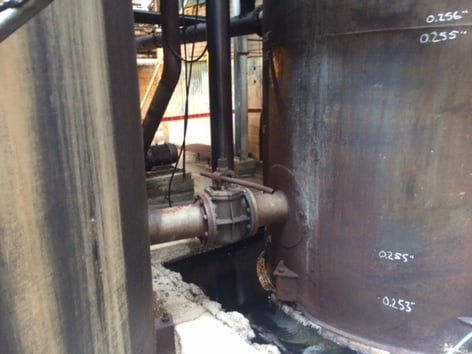Just How to Make Certain Compliance with Tank Welding Inspection Criteria
Just How to Make Certain Compliance with Tank Welding Inspection Criteria
Blog Article
The Important Duty of Container Welding Inspection in Ensuring Structural Integrity and Security Compliance in Industrial Applications
In the world of industrial applications, storage tank welding evaluation becomes a critical element in guarding architectural integrity and making certain conformity with security guidelines. Making use of a mix of techniques such as visual evaluations and advanced screening approaches, these examinations serve to determine and reduce potential flaws prior to they rise into significant dangers. The implications of these practices prolong past simple governing adherence; they fundamentally impact operational efficiency and possession durability. The complexities bordering the inspection procedure prompt a closer examination of its techniques and end results, exposing layers of significance that advantage additional expedition.
Value of Storage Tank Welding Inspection

Guaranteeing conformity with market requirements and laws is another significant aspect of storage tank welding inspection. Governing bodies mandate rigorous guidelines for the construction and maintenance of tank, and detailed inspections help organizations abide by these needs. Non-compliance can result in extreme charges, consisting of penalties and closures, better emphasizing the requirement for strenuous assessment methods.
Additionally, container welding evaluation plays a vital role in maintaining operational efficiency. In summary, the significance of storage tank welding assessment exists in its ability to guard public health, secure the atmosphere, and guarantee conformity with regulative structures.
Secret Examination Methods
Reliable tank welding evaluation counts on a variety of essential methods that make certain thorough evaluation of weld quality and structural integrity. Amongst one of the most common techniques are visual inspection, ultrasonic screening, radiographic testing, and magnetic fragment testing - Tank Welding Inspection. Each method offers distinct benefits in assessing various aspects of the weld
Aesthetic examination works as the very first line of defense, allowing assessors to determine surface issues, irregularities, or variances in the weld grain. Ultrasonic testing utilizes high-frequency acoustic waves to discover interior defects, such as fractures or voids, offering an extensive assessment of weld honesty. This approach is especially reliable in identifying concerns that might not be noticeable externally.
Radiographic testing uses X-rays or gamma rays to produce photos of the welds, revealing interior stoppages and giving a permanent document for future recommendation. This method is highly efficient for essential applications where the danger of failure need to be reduced.
Finally, magnetic particle testing is utilized to identify surface and near-surface flaws in ferromagnetic materials. By applying magnetic areas and great iron fragments, inspectors can pinpoint interruptions that might compromise the structural integrity of the tank. With each other, these techniques create a robust framework for making certain high-grade welds in commercial applications.
Conformity With Safety Specifications

Routine assessments play a pivotal function in ensuring compliance by determining prospective failures or variances from suggested standards. Examiners are educated to review weld quality, validate product specifications, and examine the overall architectural stability of storage tanks. Their proficiency is important in guaranteeing that welding procedures fulfill the needed security requirements.
In addition, compliance with safety and security standards not just protects employees yet additionally safeguards the atmosphere from potential dangers such as leaks or tragic failures. Organizations that focus on safety conformity are better positioned to reduce dangers, boost operational effectiveness, and foster a society of safety within their workforce. In summary, preserving extensive compliance with safety and security standards is essential for the effective operation of tank welding activities in commercial setups.
Advantages of Routine Examinations
Normal inspections are integral to preserving the structural integrity and safety and security of bonded containers. These evaluations give an organized method to recognizing prospective problems or weak points in the welds, making certain that any type of problems are attended to prior to they intensify right into substantial failings. By carrying out routine evaluations, organizations can spot rust, exhaustion, and various other types of deterioration that may jeopardize container efficiency.
Moreover, consistent assessments add to conformity with sector regulations and criteria. Sticking to these guidelines not only alleviates lawful dangers but additionally boosts the organization's credibility for safety and integrity. Regular assessments promote an aggressive security society, motivating workers to recognize and prioritize the importance of tools honesty.

Case Research Studies and Real-World Applications
Study and real-world applications illustrate the tangible influence of reliable tank welding examination practices. One notable example is a large petrochemical center that dealt with substantial operational interruptions because of leakages in storage space containers. Following the application of strenuous welding inspection protocols, including visual and ultrasonic screening, the center determined essential imperfections in weld seams that can have brought about devastating failings. This positive method not just prevented environmental dangers yet also conserved the firm millions in prospective cleanup prices and regulatory penalties.
Similarly, a water treatment plant executed an extensive assessment program for its tank welding operations - Tank Welding Inspection. By including non-destructive screening approaches, the plant had the ability to spot very early indicators of rust and exhaustion in weld joints. This prompt treatment expanded the life expectancy of the containers and made certain conformity with safety laws, hence guarding public health
These situation research studies highlight the significance of normal and systematic container welding examinations. By prioritizing these techniques, markets can mitigate threats, enhance architectural stability, and this contact form guarantee compliance with more tips here safety standards, inevitably bring about boosted functional effectiveness and reduced obligations.

Verdict
In verdict, container welding assessment is a crucial component of maintaining structural stability and safety in industrial applications. Using different examination methods guarantees early detection of potential flaws, thus preventing catastrophic failures. Adherence to security standards further boosts functional dependability and compliance with regulatory demands. Eventually, normal assessments not just shield public wellness and the environment yet also add to the longevity and performance of important possessions, emphasizing the vital duty of this method in commercial procedures.
Report this page